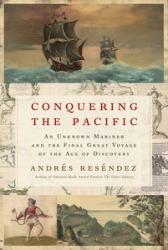 Pirates and Privateers Pirates and Privateers
The History of Maritime
Piracy
Cindy Vallar, Editor
& Reviewer
P.O. Box 425,
Keller, TX 76244-0425
    
Books for
Adults ~ Exploration, Trade, & Travel

Conquering the Pacific: An
Unknown Mariner and the Final Great Voyage of the Age of
Discovery
by Andrés Reséndez
HMH, September 2021, ISBN 978-1-328-51597-1, US $28.00
Also available in other formats
    
One great
desire of the 16th century was to find a faster
passage to Asia in hopes of dominating the European
trade of exotic spices and goods. Ferdinand Magellan
and his men made significant inroads in
accomplishing this when they circumnavigated the
world for Spain, but this accomplishment created a
dilemma. That journey took about two years to
accomplish and only eighteen of the original 270
voyagers made it home. Surely, with all her American
colonies, there had to be a way to greatly shorten
this timeframe and the Spanish king was determined
to find the elusive pieces to the puzzle that would
allow his galleons to travel from the East Indies to
Mexico, where the cargoes could be offloaded,
shipped across to the east coast, and embarked on
galleons bound for Spain.
The dilemma sounds easy to solve, but at the time,
no European knows where to find the winds and
currents that will allow ships to sail from west to
east. The Pacific Ocean complicates this because it
is so vast that it can accommodate every continent
and island the world has if gathered together in one
spot. Or, if one is foolhardy enough to swim across
this blue expanse from one continent to another, it
will take fantastical luck and a swimmer willing to
go twenty hours a day, every day for six months to
accomplish the feat.
Conquering the Pacific is the
story of finding this west-east route, how it is
accomplished, who is involved, and what the
aftermath of opening this passage means for the
men involved and for future generations.
In 1557, a cluster of ramshackle abodes dot
the landscape near a lagoon and bay on the west
coast of Mexico. Secluded Navidad is a good place to
build in secret, yet its remoteness makes it a
logistical nightmare for getting necessary supplies
and people there, and the location isn’t the
healthiest. Don Luis de Velasco, the viceroy of
Mexico, is tasked with carrying out King Felipe II’s
plan. It’s a monumental undertaking for someone with
no nautical expertise; nor is he without faults. Two
men, both of whom have crossed the Pacific Ocean
prior to this endeavor, serve as advisors: Juan
Pablo de Carrión, a resourceful and legendary
adventurer, and Friar Andrés de Urdaneta, once an
explorer with firsthand navigational experience and
now a priest. They don’t see eye to eye on many
points, especially when it comes to the route that
will be followed. Carrión suggests the Philippines,
which lies on the same latitude as Mexico, but
Urdaneta favors a more southern course to land at
New Guinea. And who will command this expedition?
The viceroy favors neither of these men, choosing
instead Miguel López de Legazpi, a scribe in charge
of accountants at the Minting House in Mexico City.
He’s not an explorer and has no navigational
knowledge. To further complicate matters, a royal
emissary investigating the viceroy’s excesses and
the members of the ruling Audiencia get involved.
Finally, in the fall of 1564, the two galleons built
at Navidad – 500-ton San Pedro and 400-ton San
Pablo – are ready to set sail. Two other
vessels complete the fleet, San Juan, which
carries forty people, and San Lucas, a
tender capable of carrying half that number. The
expedition consists of 380 handpicked men of
different class, nationality, and race with a
variety of occupational skills. Among them is an
Afro-Portuguese man named Lope Martín, an
extraordinary man skilled in mathematics, astronomy,
and cartography, who is a licensed pilot. His job is
to guide San Lucas from Navidad to the East
Indies and back again. All goes according to plan
until the Audiencia’s secret orders are revealed and
Legazpi orders San Lucas to scout ahead of
the fleet.
Reséndez weaves a fascinating account of who becomes
the first to find the west-east transpacific route.
It devolves into a race marked by human and natural
hazards, exotic locales, unfamiliar customs, tenuous
relations between islanders and crews, short
supplies, mutinies, maroonings, and accusations of
embezzlement, treason, and murder. Scientific theory
and concepts are explained in easily understood
language with modern-day examples readers will
comprehend. He also discusses how Spain and Portugal
come to “own” the lands outside of Europe, as well
as how this causes a dilemma regarding ownership of
the Philippines, the history of navigation, and what
knowledge pilots need to go from point A to point B.
Twenty-five maps are strategically placed throughout
the book. Also included are twenty-two
illustrations, a note about dates and measurements,
endnotes, and an analytical index. (The last was not
available for viewing in the galley I previewed.)
Highly recommended for any maritime history
collection that deals with the ages of exploration
and sail.
Review Copyright ©2021 Cindy Vallar

Click to contact me
Background image compliments
of Anke's Graphics |

